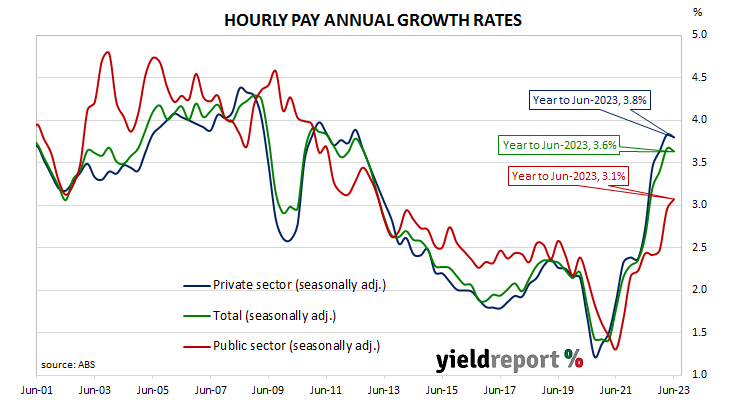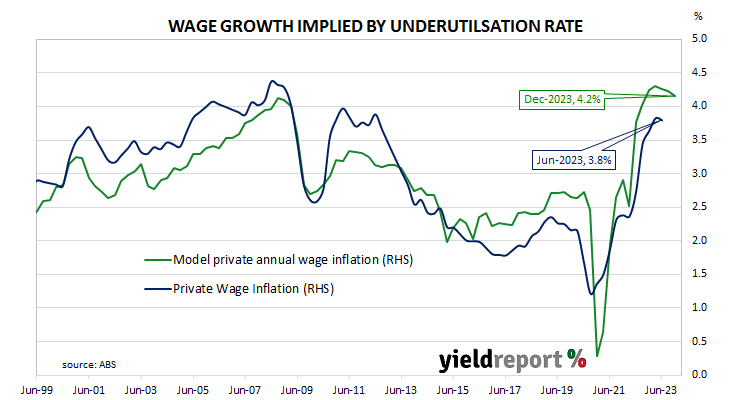Summary: June quarter wages up 0.8%, below expectations; annual growth rate slows from 3.7% to 3.6%; ANZ: 0.8% now current ‘underlying’ pace of wage growth; Westpac: minimum wage decision impact to come in Sep quarter; private sector wages up 3.8% over year, public sector up 3.1%; June underutilisation rate may imply faster wage growth in short-term.
After unemployment increased and wage growth slowed during the GFC, a resources investment boom prompted a temporary recovery back to nearly 4% per annum. However, from mid-2013 through to the September quarter of 2016, the pace of wage increases slowed, until mid-2017 when it began to slowly creep upwards. After remaining fairly stable at around 2.2% per annum from September 2018 to March 2020, the growth rate slowed significantly in the June and September quarters of 2020 before speeding up in 2021 and 2022.
According to the latest Wage Price Index (WPI) figures published by the Australian Bureau of Statistics (ABS), hourly wages grew by 0.8% in the June quarter. The result was below expectations of a 0.9% rise but in line with rises in the December and March quarters. On an annual basis, the growth rate slowed from 3.7% to 3.6%.
“With the WPI having printed at 0.8% for three quarters in a row, that would appear to be the current ‘underlying’ pace of wages growth,” said ANZ Head of Australian Economics Adam Boyton.
Domestic Treasury bond yields increased on the day. By the close of business, the 3-year ACGB yield had added 6bps to 3.96%, the 10-year yield had gained 7bps to 4.26bps while the 20-year yield finished 5bps higher at 4.55%.
In the cash futures market, expectations regarding further rate rises firmed a little. At the end of the day, contracts implied the cash rate would barely change from the current rate of 4.07% and average 4.085% in September and 4.12% in October. February 2024 contracts implied a 4.25% average cash rate while May 2024 contracts implied 4.235%, 17bps more than the current rate.
“Wage inflation has been quite disappointing compared to just how tight the labour market is and the announced outsized gain in the minimum wage this year,” said Westpac senior economist Justin Smirk. “It is true that the increase in the minimum wage is not applied until July 1st, so its main impact will appear in the September quarter…we had thought it should have some signalling impact on near-term wage bargaining.”
Wages in the private and public sectors grew by 0.8% and 0.7% respectively in the quarter. Over the past 12 months, wages in the private sector increased by 3.8% while public sector wages increased by 3.1%. Annual wage growth in the two sectors had been at 3.8% and 2.9% respectively in the March quarter.
The “underutilisation rate” is simply the sum of the unemployment and underemployment rates as per ABS monthly statistics. It has a good correlation with private wage growth two quarters in the future and thus it is useful as a leading indicator. However, differences can open up from time to time. June’s underutilisation rate suggests private wage growth may continue accelerating in the short-term.
Each quarter the ABS surveys around 3,000 private and public enterprises regarding a sample of jobs in each workplace to measure changes in the price of labour across 18,000 jobs. The results are used to construct the Wage Price Index in a manner similar to the construction of the Consumer Price Index (CPI). Changes in the WPI over time provide a measure of changes in wages and salaries, independently of the type or quantity of work.



